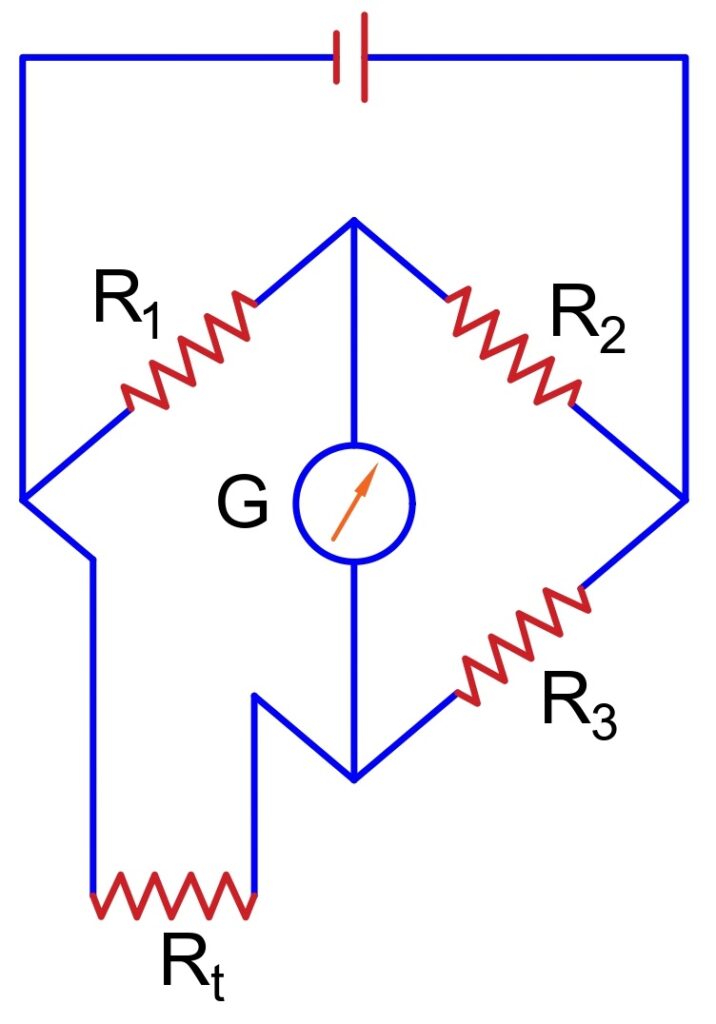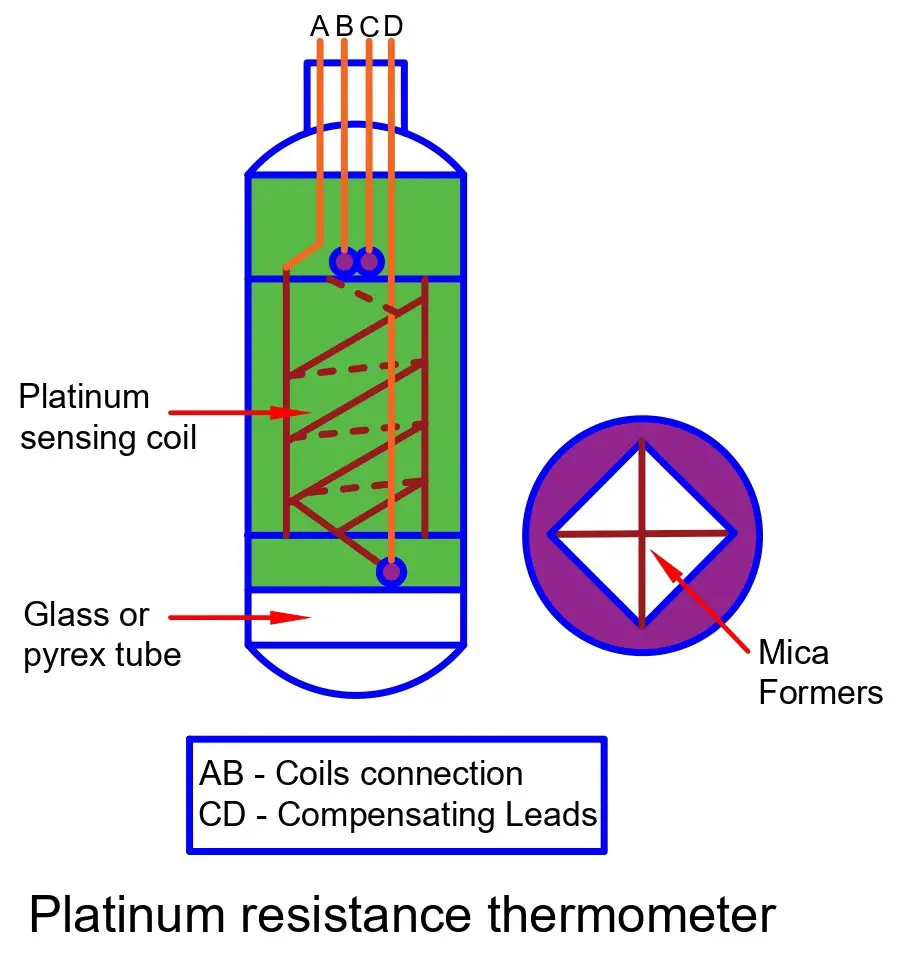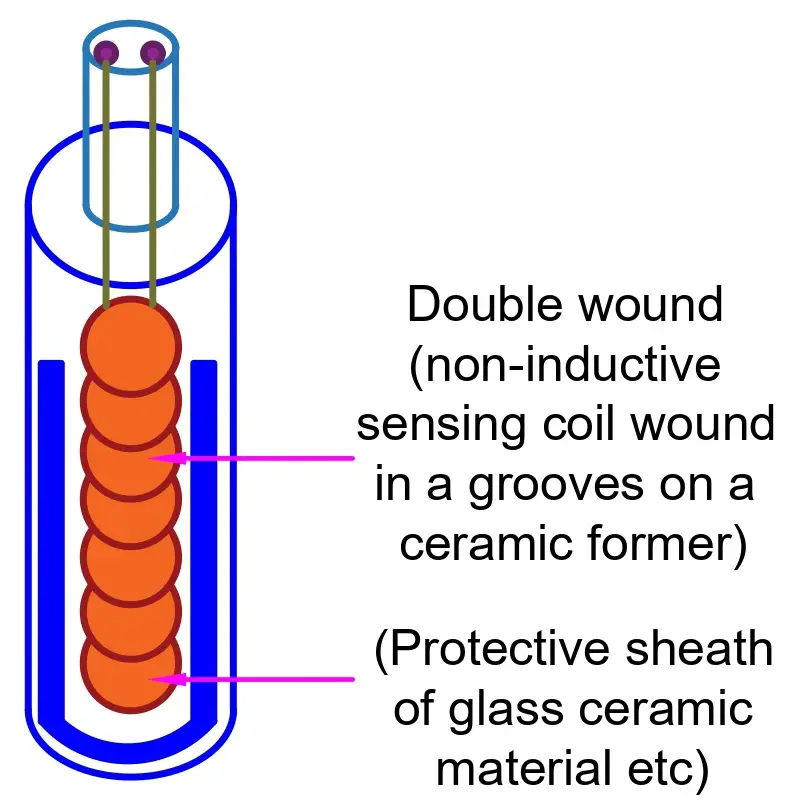Definition: The platinum resistance thermometer (PTR) uses platinum material as a thermal sensor to measure temperature. The resistance of platinum varies directly with temperature changes. It can measure the temperature in the range of 200°C to1200°C.
Platinum is the least reactive due to its high resistance to corrosion, even at high temperatures, making it suitable for temperature-sensing elements.
Working of Platinum Resistance Thermometer
The resistance of the platinum increases with an increase in the temperature, and this property is used to measure the temperature. When the platinum sensor senses the temperature, its resistance increases linearly. If you supply the alternating or direct current to the sensor, the voltage drop (IR) occurs across the sensor element. If you keep the current (I) constant, the voltage developed across the sensor is proportional to the resistance. In other words, the voltage across the sensor is proportional to the temperature, and the voltage reading is converted to temperature using a calibration equation.
The Wheatstone bridge is used to measure changes in thermometer resistance. Two long extension leads made of platinum form one arm of the Wheatstone bridge.

Construction of Platinum Resistance Thermometer
The figure shown below illustrates the platinum resistance thermometer. The thermometer consists of a platinum sensing coil and is enclosed in a bulb, which can be made of either glass or Pyrex. On the glass tube, an insulator, which is known as a sheath, is deposited and senses the temperature. The insulator deposit (sheath) on the glass tube provides excellent thermal conductivity and insulates the sensing coil from its surroundings. The sheath protects the platinum sensing coil from damage that may be caused by external factors such as moisture, dust, or physical impact.

The length and diameter of the platinum wire used in thermometers are selected in such a way that the resistance of the device is approximately 100 ohms at around 0 ºC, and its resistance varies by approximately 0.4 ohms per ºC.
The platinum double wire is wound around the mica strip in the PTR to reduce the inductive effect. The mica strip is used as an insulator and is placed at the ends of the tube.
The Ebonite cap is placed at the open end of the tube. The terminals of the copper wire are connected together using a thick copper lead. The other end of the copper leads is connected to the terminal AB, which is fitted in the Ebonite cap. To reduce the impact of copper wire resistance on the thermometer, two similar copper wires are connected to the upper-end terminals called CD. These wires are known as the compensating lead.
The figure below shows an industrial-type thermometer. The platinum wire is safeguarded by either a stainless steel tube or a glass coating, while the sensing element is sealed with glass or ceramic. This sealing has two benefits: it provides strength to the thermometer and protects the sensing element from chemical reactions.

If the PRT is intended for use in a fluid or gas, a thermowell may be added to protect the sensor from the flow and provide additional mechanical protection.
Advantages
The advantages of PTR are listed below.
- Temperature measurement by PTR is easier than with a gas thermometer.
- It gives precise temperature readings
- PTR has a stable value of resistance within its operating range.
- It has a wide range from 200 to 1200° Celsius.
- The platinum resistance thermometer changes its resistance significantly with temperature and is highly sensitive.
- The platinum has the same resistance at the same temperature; therefore, its repeatability is good.
Disadvantages
The disadvantages of platinum thermal resistance are listed below.
- Slow response.
- The platinum material above 1200°C starts to evaporate and melts at 1800° Celcius. They can not be used for measuring temperatures above 1200°C.
Platinum Resistance Thermometer Formula
This thermometer, invented by Callendar in 1877, measures temperature by detecting changes in the resistance of a platinum wire. The equation for this change is:

Where θ represents the temperature change, and α and β are constants, with β being much smaller than α. Hence, we can ignore the term β² and assume that the resistance of the wire varies uniformly with temperature. ‘a’ represents the temperature coefficient of resistance of the material. For platinum, a = 3.8×10-4 oC-1.
Solved Example:
A platinum resistance thermometer reads 0°C when its resistance is 100 ohms and 100°C when its resistance is 139 ohms. Find the temperature when PTR resistance is 120 ohms.
Solution:
Given data:
R1 =120 Ω
R0= 100 Ω
R100= 139 Ω
